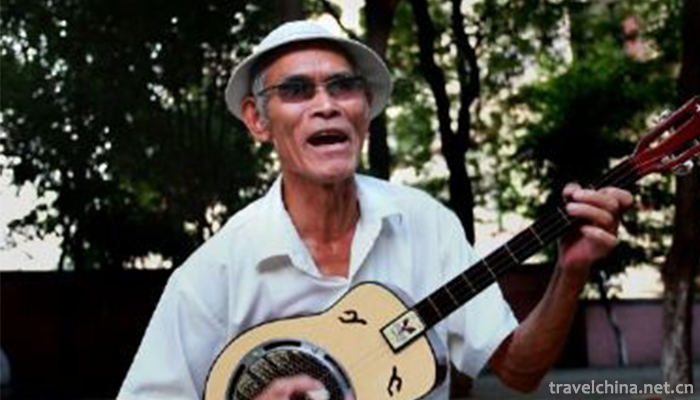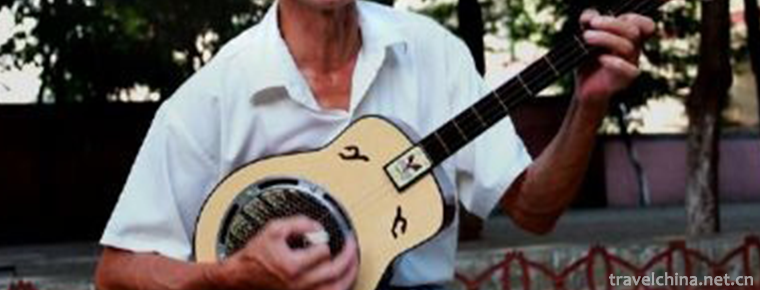Hakka ancient prose
Hakka ancient prose
As early as the late Ming Dynasty and early Qing Dynasty, Hakka ancient prose had been formed, mainly distributed in Gongjiang Town, Xinpi Township, Kuanta Township, Zishan Town, Luojiang Township, Duanwu Township and other towns in Duxian County. Most of the people who sing ancient Chinese are blind. They make a living by singing ancient Chinese. The content of singing is mainly some ancient legends, myths and historical stories that are spread among the people. Hakka ancient prose is mostly completed by a blind artist alone, so there is no overly complex requirement in clothing and props. The instruments used are generally hook, erhu, bamboo board, bangzi, fishing drum, small drum and so on. Sometimes, suona will appear. Some artists also have several jobs. They skillfully combine various musical instruments and fully use their limbs to perform them, which makes the audience sigh. Observation.
Ancient Hakka prose is a kind of rap and singing art, "one person, one drama", which is mainly based on dialect. Its performance is flexible and convenient. Its props are light and simple. Its singing tone is graceful and graceful. Its basic tune structure is mostly four sentences. The musical singing tone has strong local Hakka color. Its copies, tunes and music as well as its expression methods are of great research value.
Hakka ancient prose was listed in the National Intangible Cultural Heritage Representative project list in 2014. Cabbage


-
1.Mixed Congee
Eight treasures, also known as Laba porridge, porridge, Chinese traditional festival food. It is a gruel made from a variety of ingredients in Laba. Chinese scholars in the Southern Song Dynasty
Time 2018-11-02 -
2.Dunhua Liudingshan Cultural Tourist Area
Dunhua Liudingshan Cultural Tourist Area is located in the South Bank of Mudanjiang River, 3 kilometers south suburb of Dunhua City
Time 2018-12-05 -
3.Huanshui Bay Hot Spring Resort
Huanshui Bay Hot Spring Tourist Area of Anyang City is located at the exit of Anlin Expressway in Anyang Hi-tech Development Zone, Henan Province, close to National Highway 107 and the west side of Be
Time 2019-01-17 -
4.Huangze Temple
Huangze Temple is the only sacrificial temple for Empress Wu Zetian in China. It is located on the West Jialing River in Guangyuan City, Sichuan Province. In 1961, it was announced
Time 2019-01-18 -
5.Huang Yaguan the Great Wall
The Great Wall of Huangyaguan lies in the mountains 28 kilometers north of Jizhou District. Historically, there were 18 garrison piers and abutments in Jizhou City. Huangyaguan Pass
Time 2019-01-19 -
6.Longtan Park
Longtan Park is located opposite Longtan Beili District, Dongcheng District, Beijing (Chongwen District), and is currently a national 4A-level tourist park. Longtan Park
Time 2019-02-06 -
7.Browns Folk Songs
The folk songs of the Browns are rich in content and many melodies. Every time they get married, move to a new house, celebrate New Year's Day or work, young people
Time 2019-04-04 -
8.Miao Batik Dyeing Techniques
Batik dyeing is one of the ancient folk traditional printing and dyeing techniques of the Chinese nation. As early as the Qin and Han Dynasties, the Miao people had mastered batik dyeing techniques, a
Time 2019-06-05 -
9.Harmonic Qin
In the history of Harmonious Qin, young men and women in Nima Township, Bango County, Naqu Prefecture, Tibet had a tradition of gathering to dance Harmonious Qin. Whether it was the end of farming or
Time 2019-07-06 -
10.Month also
Dong people's "moon" means collective visiting, which is a social custom in Dong village. The young men and women in one village of the Dong nationality visit another village according to th
Time 2019-07-16 -
11.Zhou Cuns Baking Cake Making Skills
Zhou Cun's baking technology has a history of more than 1,800 years. According to Zizhi Tongjian, in the three years since Emperor Heng of Han Dynasty Yanxi, Hucai vendors have been exiled in Shandong
Time 2019-08-10 -
12.Collection value of Chinese embroidery
Mr. Chen, a fan of antique collection, bought a silk embroidery at Fuzhou flea market for more than 10000 yuan 19 years ago, which is worth at least 300000 yuan by 2008. This embroidery, about 1.8 meters long, has a dark red background, with butterfly
Time 2020-12-12